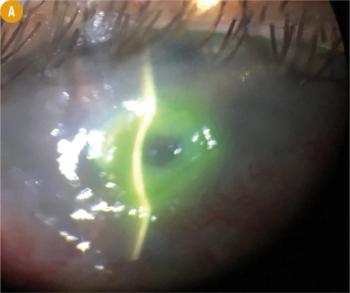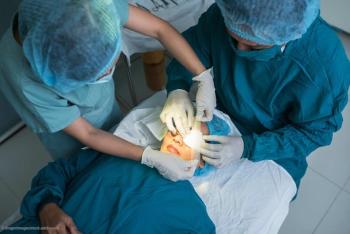
Topical cenegermin has been approved by the FDA for the treatment of moderate-to-severe neurotrophic keratitis (NK), ushering in a breakthrough of management.

Topical cenegermin has been approved by the FDA for the treatment of moderate-to-severe neurotrophic keratitis (NK), ushering in a breakthrough of management.





The 2017 meeting of the American Academy of Ophthalmology will convene in New Orleans from Nov. 11 to 14. Go to www.aao.org/annual meeting for the latest updates

The most recent analyses of data from the ARMOR (Antibiotic Resistance Monitoring in Ocular micRoorganisms) Surveillance Program can guide clinicians choosing antibiotic therapy for initial empiric therapy and infection prophylaxis. The information also reinforces the importance of prudent antibiotic prescribing to limit the development of bacterial resistance to existing options, according to Penny Asbell, MD.

Ophthalmology Times asked readers for insights on antibiotics and eye infections from clinicians in the field - including experience with postoperative infections after eye surgery, if you use topical antibiotic prior to cataract surgery, how you choose antibiotics in a routine surgical prophylaxis, and more. The 118 U.S.-based ophthalmologists who responded were entered into a drawing to win a $200 gift card. Here are the survey results.

Patients with a contact lens lost in the eye are not a rare occurrence for ophthalmologists. However, 27 lenses at the same time may be another story! Another ophthalmologist shares his experience with a case involving 5 lenses within a patient's eye.

Cataract surgery in eyes undergoing simultaneous endothelial keratoplasty requires several modifications in techniques.

A phase II study investigating a novel topical cyclosporine product (CyclASol, Novaliq) formulated in a semifluorinated alkane (SFA) vehicle showed promising efficacy, safety, and tolerability. Planning is ongoing for the phase III trial of cyclosporine in the SFA technology.

Using the Descemet’s membrane endothelial keratoplasty (DMEK) procedure can produce better visual results and lower risk of rejection than using the previous methods (DLEK and DSAEK). The method has become easier to learn and use than in the past, and should be considered as the primary EK procedure for most routine cases of endothelial failure.

Advances in presbyopia, dry eye and allergy, and age-related macular degeneration filled this year’s meeting of the Association for Research in Vision and Ophthalmology.

As part of a transformation to one of the pioneering eye banks in the country, Tissue Banks International (TBI) recently underwent a formal rebranding, changing its name to KeraLink International. This move included shedding the musculoskeletal portion of operations to concentrate on dramatically increasing the number of sight-saving procedures performed globally, explained Douglas Furlong, KeraLink’s president and chief executive officer.

Lifitegrast ophthalmic solution 0.05% (Xiidra, Shire) has demonstrated positive results for the treatment of the signs and symptoms of dry eye disease. Eye dryness scores for some patients have improved after two weeks of treatment with the topical drop.

Patient symptoms are not an effective method to diagnose dry eye, as they often overlap with other pathologies. Tear osmolarity results provide clues for alternative diagnoses.

Poor regeneration of the epithelial basement accounts for most 'late haze' associated with PRK, LASIK, infections, or corneal transplants. Proper excimer laser maintenance may reduce irregularities.

Recombinant human lubricin showed potential as a new therapeutic approach to the management of dry eye disease in a small clinical trial. Compared with sodium hyaluronate, lubricin (Lubris BioPharma), significantly improved both signs and symptoms of moderate dry eye after two weeks of treatment.

Seasonal and perennial allergic conjunctivitis are common conditions that are not always well-controlled with conventional therapy. Alternative approaches and novel investigational treatments are discussed.

A phase I/II trial enrolling patients with Sjögrens syndrome dry eye will be investigating a synthetic fragment of a naturally occurring tear glycoprotein. Findings from extensive laboratory and preclinical research suggest that it is a promising novel therapy.

Chronic dry eye disease (DED) affects more than 25 million people and to date the only pharmacologic therapies are topical or involve punctal plugs. Results from two studies wth a neurostimulator indicate there may be a new pathway to upregulate the body’s tear system.

Using dysfunctional lens syndrome stages, physicians can discuss a range of treatment options with patients, based on clinical findings and refractive error.

In 2016, Vision Share eye banks provided more than half the supply of U.S. donor corneas with over 20,000 placements. It has worked to build the largest network of non-profit eye banks in the world, with 13 members and 20 eye banks in the United States and a vast network of providers at home and abroad.

Use of a handheld circular polarizing filter to intercept afferent and efferent light from a slit lamp or operating microscope highlights corneal structures that are otherwise invisible or barely seen.

Though much research is happening in the diagnosis and treatment of viral eye infections, much of it might not be readily apparent to clinicians, explains Todd P. Margolis, MD, PhD.